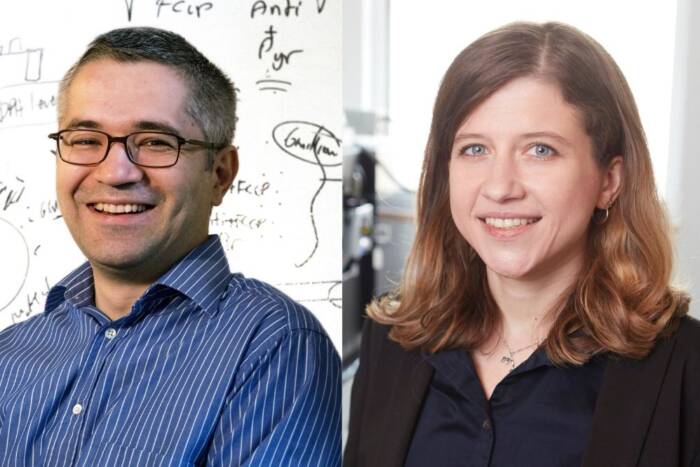Robert Darnell named president of New York Genome Center
By Zach Veilleux
Sometime during the last decade, as he developed technology to explore the role of RNA in neurological disease, Robert B. Darnell realized that the talented, highly educated molecular biologists in his lab were spending more and more of their time doing something that they had never been trained to do: processing computational data. The price of sequencing was falling and the amount of information being generated was staggering. If their work was going to proceed at the pace Dr. Darnell wanted it to, he was going to need a new kind of assistance.

Genomic infrastructure. Architectural rendering of the outside of the New York Genome Center’s new facility at 101 Avenue of the Americas (top); Dr. Darnell (bottom).
This realization, and the developments that followed it, led to Dr. Darnell’s involvement in the establishment of the New York Genome Center (NYGC), now on its way to becoming one of the largest genomics research facilities in North America, bringing together resources from 11 area institutions to integrate sequencing, bioinformatics and data management capabilities in one centralized location. And it ultimately made Dr. Darnell the logical choice to serve as the NYGC’s first president and scientific director, a position to which he was named in November.
In his role, Dr. Darnell will direct all aspects of the NYGC, including its scientific and research activities and the recruitment and development of a world-class scientific team in genomic research, computational science and medicine. He will lead a collaboration that will help push forward genomic science, ultimately providing advances that will lead to a new era of personalized medicine, accelerating the development of new diagnostics and treatments for human diseases, and providing an engine for life science commercialization in the region.
Dr. Darnell’s lab pioneered translational studies in paraneoplastic neurologic syndromes, which linked tumor immunity to autoimmune brain disease and have led to new antitumor strategies being tested in cancer patients. But studying these patients also led his team to discover neuron-specific systems that regulate RNA expression, and to the invention of HITS-CLIP, now the gold standard with which to study RNA regulation. This opened the door to understanding the complex world of what is now sometimes referred to as the “dark matter” of the genome — the 75 to 80 percent of our DNA that is transcribed into RNA but that does not encode protein domains.
“In 2003, when we first developed CLIP technology, we sequenced 400 RNA tags and mapped them to specific sites from among the billions of sequences present in our genome, for a cost of $4,000. Today we can sequence over 30 billion tags for that same $4,000, and do it in a single day,” says Dr. Darnell, who is Robert and Harriet Heilbrunn Professor and head of the Laboratory of Molecular Neuro-oncology. “This is truly transformative; it allows us to begin to look at the next generation of genomics — understanding the role of RNA dark matter in biology and in disease — in an unbiased and unrestricted manner. But the downside is that enormous datasets are being generated, and fed to a wet lab full of scientists trained in molecular biology.
“Our initial response was to think and learn about genomics and bioinformatics on our own, and we were lucky enough to recruit and collaborate with a number of extremely talented individuals to help us. But we also recognized that data management and data analysis was really being done on an inadequate basis from within our own group. Helping NYGC develop was, for me, a logical extension of the perceived needs within my laboratory, within The Rockefeller University and within the groups of my colleagues around New York City.”
Founded just two years ago, in August 2010, the NYGC is an independent, nonprofit organization that leverages the collaborative resources of leading academic medical centers, research universities and commercial organizations. It is currently building out its 7,000 square foot facility at 101 Avenue of the Americas. The $47 million build-out will be completed by the middle of next year and will eventually house up to 500 employees.
“Leading the New York Genome Center is a position for which Bob is exceptionally well-suited, given his vast experience in the field of genomics and translational research,” says President Marc Tessier-Lavigne, a member of the NYGC’s board. “The university’s link to NYGC is going to be a great asset for us in the coming years, as the center facilitates the sharing of data and resources and increases the quality and speed of research in the greater New York City area, and Bob will be an excellent leader.”
Work from many labs, at Rockefeller and elsewhere, has shown that small domains within RNA dark matter can be critically important in cell function and in disease. “I believe that the scope of the problem, and its potential to transform basic and clinical medicine, is so enormous that it will only be surmounted by a multi-pronged pooling of minds and scientists, ranging from clinicians to genomic biologists to computing experts to mathematicians,” says Dr. Darnell. “The NYGC is the expression of this belief, and will bring together, in a not-for-profit academic consortium, the greatest minds in genomics from nearly every scientific institution in New York, for the benefit of humanity.”


